
Knowledge
Disadvantages of Sand Casting
(1)Rougher Surface Finishes
One of the most notable drawbacks of sand casting is its tendency to produce rough surface finishes on cast parts.
The texture of the sand mold transfers onto the final product, resulting in surface irregularities that may not meet the desired aesthetic or functional requirements of the project.
As a result of the rough surface finishes sand casting produces, additional finishing processes such as machining, painting, or sandblasting are often necessary to achieve the desired surface quality.
Post-casting finishing not only adds to production time and costs, but also introduces the potential for dimensional variations if not executed meticulously.
If we take, for example, the production of decorative or consumer goods where visual appeal is paramount, the rough surfaces resulting from sand casting would more than likely necessitate extensive finishing work to achieve the desired aesthetic quality.

In this instance, the additional processing that would be needed to meet surface finish requirements would almost certainly increase lead times and production costs, thereby potentially impacting overall project timelines and budgets.
(2)Lower Dimensional Accuracy
Compared to some other casting methods, such as investment casting and die casting, sand casting tends to exhibit lower dimensional accuracy and tighter tolerances.
Variations in the sand mold’s composition, moisture content, and compaction can lead to dimensional deviations in the final cast parts.
Achieving precise dimensional accuracy in sand casting requires careful attention to mold design, gating systems, and process parameters.
However, even with such meticulous planning and execution, there may still be inherent limitations to the achievable tolerances, particularly for intricate or large-scale castings.
Take automotive manufacturing, for example.
This is an industry where tight dimensional tolerances are crucial for ensuring the proper fit and functionality of engine components.
Therefore, the inherent dimensional variability of sand casting may pose steep challenges.
For example, parts such as engine blocks and transmission housings would most likely require additional machining operations to meet precise dimensional specifications if the sand casting process were used.
This would, in turn, add complexity, time, and cost to the production process, making sand casting disadvantageous.
(3)Higher Likelihood of Defects
Furthermore, sand casting is susceptible to a range of defects that can compromise the integrity and quality of cast parts.
Common sand casting defects include shrinkage, cold shuts, gas porosity, and sand inclusions.
The defects the process incurs often arise due to factors such as inadequate mold design, improper gating and risering, and variations in casting parameters.
Addressing such defects often requires extensive quality control measures, including non-destructive testing, visual inspections, and corrective actions such as re-melting and recasting.
If these measures are not taken, then the potential for higher production costs and lower performance and reliability will rise.
If we take a look at industries where safety and reliability are paramount (e.g. aerospace), we see that the presence of defects in critical components such as turbine blades or structural elements can have severe consequences.
That is why sand casting is often not a viable option for such applications.
However, if sand casting is used in these instances, then quality control protocols must be used to detect and mitigate any defects early on in the production process to secure a quality metal cast part.
As was just mentioned, despite its many advantages, sand casting is not without its challenges.
Problems such as rough surface finishes, lower dimensional accuracy, and the risk of defects must be contended with when employing the process.
However, with the proper understanding of these disadvantages, manufacturers can implement effective quality control measures that help mitigate risks and optimize the process to deliver higher-quality castings that meet the demands of diverse industries.
For more information, you can write to our mailbox info@castings-forging.com or call us at 029 81161513



